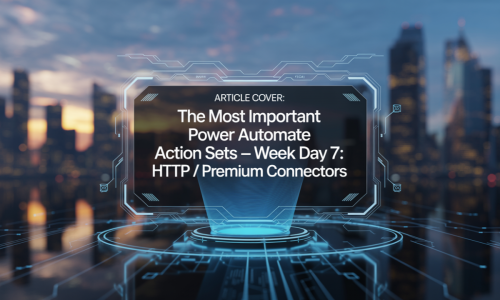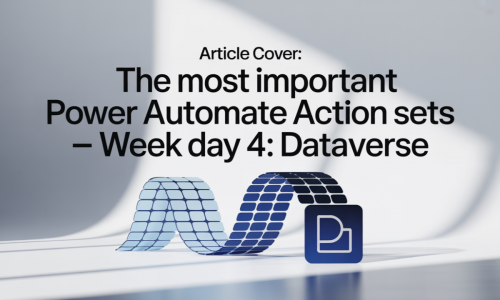Power Platform Bad Decision Week Day 2 – Citizen Developers With God-Mode Access: What Could Possibly Go Wrong?
-
Admin Content
-
Oct 03, 2025
-
226
Welcome back to Bad Decision Week! Today’s cautionary tale dives into a scenario that’s more common than you might think—giving citizen developers unrestricted, god-mode access in the Microsoft Power Platform. On the surface, this move might seem empowering, innovative, even efficient. But peel back the layers, and you’ll find it can quickly spiral into chaos.
In an age where digital transformation is a necessity and automation tools are democratized, citizen developers can be a tremendous asset. However, giving them unchecked access to environments, connectors, data, and settings without proper governance is like handing the keys of a Ferrari to someone who just passed their driving test. They might be enthusiastic—but that doesn’t mean they’re ready for the Autobahn.
Let’s explore why this is such a critical misstep, what the implications are, and how organizations can strike the right balance between empowerment and control.
The Rise of the Citizen Developer
Citizen developers—business users who create apps and workflows without formal coding backgrounds—are rapidly transforming how work gets done. With low-code platforms like Microsoft Power Apps, Power Automate, and Power BI, they can build tools that solve real-world problems in record time. In many organizations, they bridge the gap between IT and operations, delivering quick wins without overburdening development teams.
But herein lies the rub: speed and convenience often come at the cost of oversight. When enthusiasm isn’t tempered with training or governance, even the best intentions can lead to dangerous outcomes. Citizen developers, unencumbered by IT guardrails, may unknowingly create security holes, performance issues, or massive data exposures. While the Power Platform is robust, it’s not foolproof—and neither are the users without a proper framework in place.
The misconception is that because it’s “low-code,” it’s also “low-risk.” Unfortunately, the opposite is often true. Business users, with little knowledge of compliance, data privacy, or integration best practices, might inadvertently put the entire organization at risk.
The Dangers of God-Mode Access
God-mode access refers to giving users admin-level permissions across environments in Power Platform—permissions to create, delete, publish, connect to any data source, or even export sensitive information. While this may be necessary for a handful of trusted administrators, it’s a disaster waiting to happen in the hands of an inexperienced user.
Here are a few nightmare scenarios that stem from this poor decision:
- Accidental Data Leaks: A well-meaning sales analyst connects an app to a confidential HR database, exposing salary data to the entire sales team.
- Shadow IT Chaos: Dozens of apps and flows are created in unmanaged environments, with no naming conventions, documentation, or lifecycle strategy—causing confusion, duplication, and maintenance headaches.
- Security Gaps: A citizen developer uses a personal connector to a third-party service, introducing vulnerabilities or violating compliance regulations.
- Platform Instability: Performance suffers because an app built with inefficient logic loops causes cascading failures or eats up service limits—crippling other critical workflows.
God-mode access eliminates the natural friction that protects systems. It removes the brakes from a high-speed car and hopes for the best. Most citizen developers aren’t trying to break anything, but without proper visibility into the consequences of their actions, they often do.
How This Happens in Real Life
So how does this mistake even happen? Usually, it begins with good intentions. An IT team, eager to accelerate digital transformation, opens up the Power Platform without setting up a structured governance plan. They want to foster innovation and show trust in business users. But without clearly defining roles, environments, or permissions, they end up giving blanket access “just to get things going.”
Or maybe a company moves too fast during a pilot project and forgets to roll back permissions post-launch. Sometimes, IT isn’t even aware that certain connectors or environments are open to everyone because the admin center wasn’t reviewed or configured after rollout.
Another common scenario is when a citizen developer starts small—then suddenly becomes the go-to “app person” for a department. They get access after access, their apps scale far beyond their original purpose, and before long, they’re managing dozens of mission-critical apps without any support or visibility.
All of this compounds until one day, something breaks. And when it does, there’s often no documentation, no audit trail, and no clear owner to fix it.
Building a Safer Power Platform Strategy
So what’s the solution? How can organizations continue to empower citizen developers without veering into chaos?
- Establish Clear Governance: Start with defining who can do what. Create dedicated environments for development, testing, and production. Use data loss prevention (DLP) policies to control which connectors can be used and by whom.
- Limit Access by Design: Not every user needs global admin rights. Leverage security roles and environment roles to tailor access to what’s actually required.
- Educate and Train: Empowerment doesn’t mean throwing users into the deep end. Offer training on platform basics, best practices, and responsible usage. Teach them how to document, maintain, and monitor their apps.
- Set Up CoE (Center of Excellence) Kits: Microsoft’s CoE Starter Kit can help standardize governance, automate audits, and build transparency into platform usage.
- Regularly Review and Audit: Permissions, usage, and environments should be reviewed quarterly. Make it a habit to prune unused apps and identify high-risk usage patterns before they escalate.
By putting a structure around your Power Platform strategy, you ensure that innovation doesn’t come at the cost of stability. You make room for experimentation—but within a safe, monitored environment.
Final Thoughts: Trust, But With Boundaries
The spirit of the Power Platform is rooted in empowerment. It’s about enabling those closest to the problem to solve it. But empowerment without boundaries isn’t innovation—it’s anarchy.
Giving citizen developers god-mode access might feel like a shortcut to faster results, but it often leads to longer-term problems, technical debt, and even legal or compliance nightmares. The goal should be to cultivate a garden—not a jungle. Structure, training, and boundaries aren’t constraints—they’re what make sustainable growth possible.
So as we reflect on this Day 2 mistake, let it be a reminder: Trust your citizen developers—but set them up for success by building a framework that protects everyone involved.





